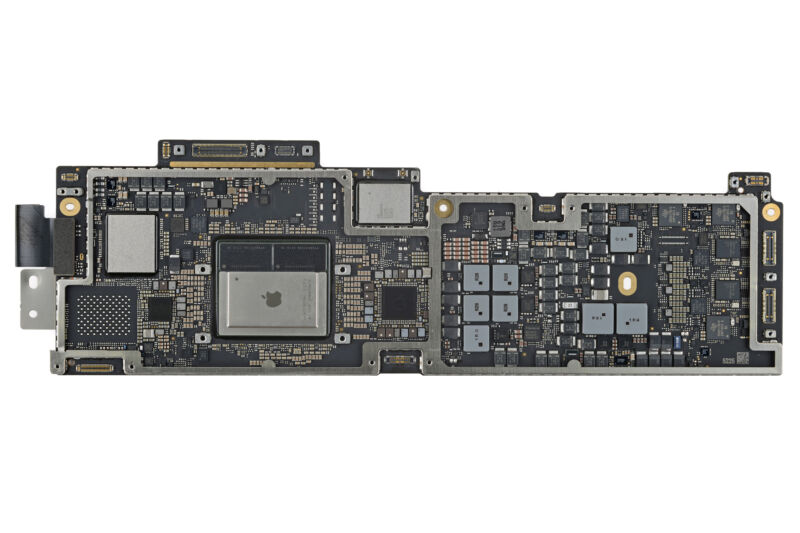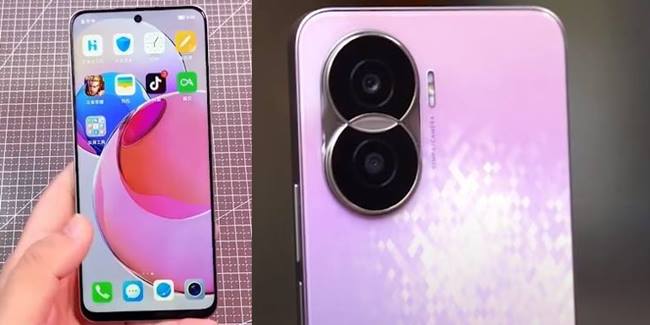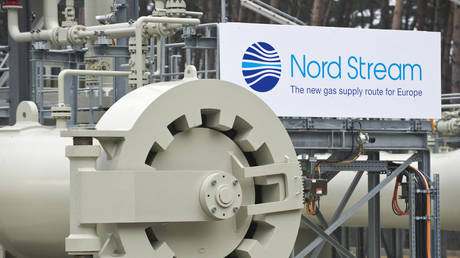[ad_1]

iFixit
If you happen to learn iFixit’s teardowns, in-depth opinions, or observe any tech YouTubers, you’ll have realized that the brand new M2-equipped MacBook Air is heatsink-less, along with being fanless.
Whereas not one thing each MacBook Air proprietor will discover, we ran some exams, and the M2 MacBook Professional was 30 % quicker than the very same M2 within the MacBook Air. Extra adventurous YouTubers have gone additional—the Max Tech channel put in skinny thermal pads on the MacBook Air’s M2 that considerably boosted the chip’s efficiency in each real-world and artificial benchmark exams, whereas decrease the chip’s most temperature from a toasty 108° Celsius to a less-toasty 97° Celsius.
Thermal pads, heatspreaders, and heatsinks all work the identical manner: they make shut contact with the processor and conduct warmth away from it. As that warmth is unfold over a bigger floor space, it turns into simpler to dissipate, making it simpler to maintain the processor cool. The M1 MacBook Air included a passive heatspreader (that’s, one and not using a fan) that performed warmth away from the chip, whereas the M1 and M2 MacBook Execs use lively cooling methods that pull in cool air and eject sizzling air for much more efficient cooling.
The M2 MacBook Air does not have a passive or lively cooling system. That is widespread for the corporate’s cellphone and pill chips, which do not get as sizzling because the M2. But it surely is an odd design determination for a laptop computer, particularly provided that Apple included a heatspreader within the earlier Air, and that the M2 is a bigger, hotter chip than the M1 within the first place.
Earlier than we proceed, this mod is not one thing that we condone. Other than voiding your new MacBook Air’s guarantee, including thermal pads that conduct the M2’s warmth to the underside of the laptop computer might trigger all types of unintended penalties, together with however not restricted to “making your lap actually sizzling.” You additionally danger inflicting unintended injury to the M2 or different elements. Severely, please don’t mod your new MacBook Air simply because a YouTuber did it (or at the least give different folks extra time to find all of the unintended negative effects in order that you do not have to).
That stated, that is a part of an unlucky sample for the MacBook Air—the 2020 Intel MacBook Air was additionally able to higher efficiency than it delivered, and the offender was additionally the cooling system.
In an actual do-as-I-say-and-not-as-I-do scenario, I modded my 2020 Intel MacBook Air, so I can communicate with extra authority on its cooling points. The issue there wasn’t that Apple did not embody a heatsink and fan, however that the heatsink was arrange poorly—there was too giant a niche between the underside of the heatsink and the highest of the processor, and Apple had to make use of a bigger glob of thermal paste to shut that hole. However the place a skinny layer of thermal paste can fill in tiny gaps and enhance conductivity and warmth switch, too a lot thermal paste results in a a lot less-efficient switch of warmth. Oops! Doable fixes for the problem embody utilizing skinny copper shims to shut the hole between the CPU and the heatsink, in addition to putting a thermal pad on high of the Air’s heatsink to enhance conductivity.
Though the causes of the thermal issues in these two MacBook Airs are totally different, each issues actually really feel avoidable. Possibly Apple is attempting to avoid wasting cash, or make the MacBook Air a tiny bit lighter. Possibly the corporate thinks that the efficiency degradation will not truly be noticeable by most individuals more often than not (which might be true). Possibly the corporate does not suppose most individuals will use their MacBook Airs for sustained workloads that make the processor hit its thermal limits (although this is able to be an odd assumption to make, given the corporate’s renewed curiosity in gaming in macOS Ventura and the MacBook Air’s place as Apple’s hottest laptop computer).
No matter Apple’s reasoning, letting the M2 run at increased temperatures over a few years might ultimately turn out to be a reliability problem—the warmer laptop elements run, the quicker they put on out. That is additionally the MacBook Air design we’ll in all probability reside with for the subsequent three to 5 years, going by precedent. Apple ought to be cooling all of those methods correctly, for the great of the {hardware} and the folks utilizing it.
[ad_2]
Source link




















